
Passiflora, known also as the passion flowers or passion vines, is a genus of about 550 species of flowering plants, the type genus of the family Passifloraceae.
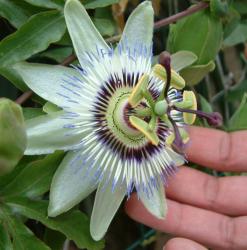
The Passifloraceae are a family of flowering plants, containing about 750 species classified in around 27 genera.

Passiflora foetida is a species of passion flower that is native to the southwestern United States, Mexico, the Caribbean, Central America, and much of South America. It has been introduced to tropical regions around the world, such as Southeast Asia, South Asia, Hawaii, Africa, and The Maldives. It is a creeping vine like other members of the genus, and yields an edible fruit. The specific epithet, foetida, means "stinking" in Latin and refers to the strong aroma emitted by damaged foliage.
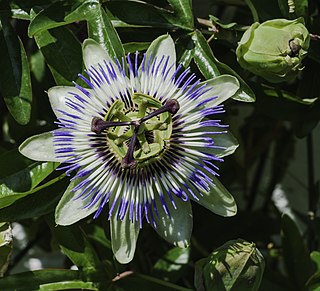
Passiflora caerulea, the blue passionflower, bluecrown passionflower or common passion flower, is a species of flowering plant native to South America. It has been introduced elsewhere. It is a vigorous, deciduous or semi-evergreen tendril vine growing to 10 m (33 ft) or more. Its leaves are palmate and fragrant, flowers blue-white with a prominent fringe of coronal filaments in bands of blue, white, and brown. The ovoid orange fruit, growing to 6 cm (2 in), is edible but bland.
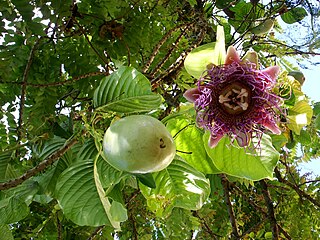
Passiflora quadrangularis, the giant granadilla, barbadine (Trinidad), grenadine (Haiti), giant tumbo or badea, is a species of plant in the family Passifloraceae. It produces the largest fruit of any species within the genus Passiflora. It is a perennial climber native to the Neotropics.
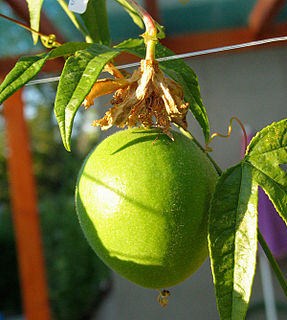
Passiflora incarnata, commonly known as maypop, purple passionflower, true passionflower, wild apricot, and wild passion vine, is a fast-growing perennial vine with climbing or trailing stems. A member of the passionflower genus Passiflora, the maypop has large, intricate flowers with prominent styles and stamens. One of the hardiest species of passionflower, it is both found as a wildflower in the southern United States and in cultivation for its fruit and striking bluish purple blooms. Passiflora incarnata fruit contain many seeds, each surrounded by an aril holding edible juice, and this juice can be consumed fresh or used to flavor processed products.
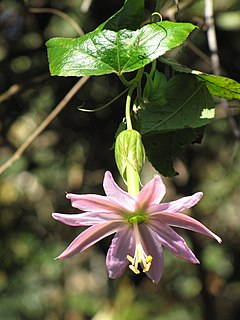
Passiflora tarminiana is a species of passionfruit. The yellow fruits are edible and their resemblance to small, straight bananas has given it the name banana passionfruit in some countries. It is native to the uplands of tropical South America and is now cultivated in many countries. In Hawaii and New Zealand it is now considered an invasive species. It was given the name banana passionfruit in New Zealand, where passionfruit are also prevalent. In Hawaii, it is called banana poka. In its Latin American homeland, it is known as curuba, curuba de Castilla, or curuba sabanera blanca (Colombia); taxo, tacso, tagso, tauso (Ecuador); parcha, taxo (Venezuela), tumbo or curuba (Bolivia); tacso, tumbo, tumbo del norte, trompos, tintin or purpur (Peru).
Passiflora brachyantha is a species of plant in the family Passifloraceae. It is endemic to Ecuador.

Passiflora tripartita also called curuba, tumbo, curuba de Castilla and tumbo serrano is a species of Passiflora from Peru, Bolivia, Ecuador, Colombia, and Brazil in areas at elevations of 2000 – 3200 meters.

Passiflora maliformis, the sweet calabash, conch apple, wild purple passionfruit, or sweet cup, is a smallish (5cm) passionfruit with purple, yellow or green skin and a greyed-yellow to orange pulp that is aromatically scented and -flavoured. It is a fast-growing vine, growing best in somewhat cooler-than-tropical climates. The rind is particularly hard and tougher than most passionfruits. It is usually eaten fresh or used to flavour drinks. It is a native to the Caribbean, Central America and Northern South America.

Passiflora suberosa is a species of passionflower that is native to the Americas. It is commonly known as corkystem passionflower due to the corkiness of older stems. Other common names include corky passion vine, cork-bark passion flower, corkstem passionflower and corky passionfruit. It is possibly also cryptic and have multiple species in one.

Passiflora coccinea is a fast-growing vine. The vine is native to northern South America. It produces edible fruit.

Passiflora arborea is a species of passion flower found in Colombia, Ecuador and Panama. Passiflora arborea is a freestanding tree that can grow to be 50 feet tall. They germinate anywhere from an elevation of 1400 – 2000 ft. The tree's leaves grow to be 1 to 1½ feet long. It is native to Colombia, is rarely seen in cultivation, and is one of two species of Passiflora that is not widely distributed throughout the country.
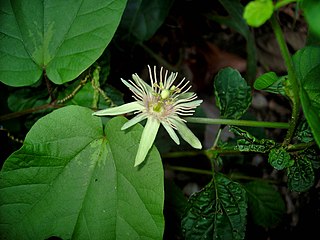
Passiflora rubra, the Dutchman's laudanum, is a species in the family Passifloraceae. It is native throughout the West Indies, and to Colombia, Venezuela, Peru, Ecuador, Bolivia and eastern Brazil.

Passiflora arbelaezii is a species in the family Passifloraceae native to eastern Nicaragua and western Colombia. This species was named in honor of Enrique Pérez Arbeláez, the person who collected the type specimen. It was first formally described in 1957 by Antonio Lorenzo Uribe Uribe. Like Passiflora discophora and Passiflora tryphostematoides this species is rather unusual within its genus, due to the specialised adhesive structures. Passiflora arbelaezii forms branched tendrils with terminal adhesive pads, which form after contact of the distal ends with the substrate. Proliferation of papillate cells ensures close adhesion to the surfaces, which are mirrored in their microtopology by the proliferating cells, in addition to adhesive secretions of the structures.

Passiflora mixta, from the family Passifloraceae is also known as curuba, curuba de indio, curuba de monte, curubita, curuba (Colombia), parcha (Venezuela), and taxo (Ecuador). Originally, it derived from the monophyletic Passiflora subgenus Tacsonia. Passiflora mixta is endemic to the Americas. A perennial vine, the Passiflora mixta is pink to orange-red in color.
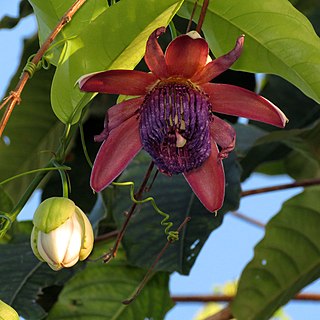
Passiflora ambigua is a species of Passiflora from Mexico, Belize, Costa Rica, and Colombia.

Passiflora cincinnata is a species of Passiflora from Brazil.

Passiflora manicata is a species of Passiflora from Colombia and Ecuador.


















